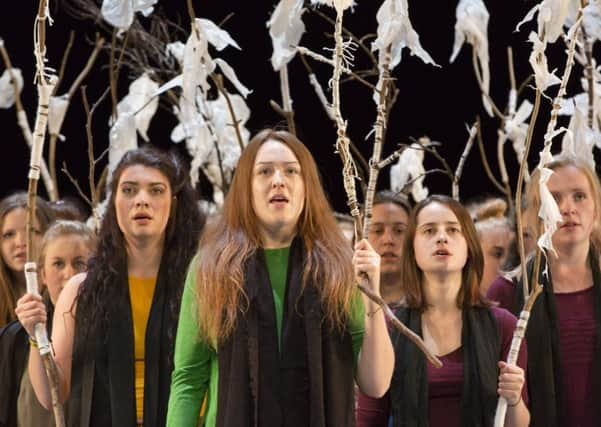Joyce McMillan on the Year in Theatre


So it’s hardly surprising that when Laurie Sansom announced his sudden departure from the NTS, just two months later, shockwaves ran through the theatre community both at home and beyond, and the future of the fledgling NTS became the dominant theatre story of the year. This year was to have been all about the emergence of David Greig as artistic director of the Lyceum, and his first autumn season there; instead, it now seems to have revolved around three moments, beginning with that roar of recognition at the Festival Theatre, continuing through Sansom’s exquisite, elegiac farewell production of The 306: Dawn at a barn in Perthshire in May – a music theatre piece by Oliver Emanuel and Gareth Williams about the 306 British men who were shot at dawn during the First World War for cowardice and desertion – and then culminating in the moment, five months later, when the NTS was able to announce the appointment of former Arches boss Jackie Wylie as its next artistic director, and to move on, into its new headquarters building at Rockvilla in Glasgow.
Beyond the NTS, though, it was another hugely busy year around Scotland’s stages; although one marked by growing apprehension about the prospects for future funding, and about a wider political climate spiralling towards crisis. The Lyceum transition between Mark Thomson and David Greig was both seamless and bold, with Greig announcing a 2016-17 programme designed to expand the theatre’s work in the face of cuts in its Creative Scotland grant, and to make the theatre an ever more vital part of the life of the city. His opening production, of his own version of Aeschylus’s refugee drama The Suppliant Women, was a brave, high-risk show involving a volunteer chorus of 30 young Edinburgh women; yet it worked, pushing the Lyceum to the cutting edge of current debate about the relationship between professional theatre and the audience it serves.
Advertisement
Hide AdMeanwhile, in Glasgow, Dominic Hill’s Citizens’ Theatre powered its way through another hugely impressive year; Hill’s spring production of This Restless House, a complete contemporary female rewrite of Aeschylus’s Oresteia by Traverse associate Zinnie Harris, was a true highlight of 2016, featuring a stunning leading performance from Pauline Knowles. The Play, Pie And Pint seasons at Oran Mor – partly co-produced by the Traverse and others – continued to act as a low-risk powerhouse for new writing, with Morag Fullarton and April Chamberlain now in charge, and brilliant new work by leading writers from Peter Arnott to Alan Bissett forming the backbone of the spring and autumn seasons. Andy Arnold’s Tron Theatre also worked its way through an impressively busy year, with Peter Arnott writing a superb new play, Shall Roger Casement Hang?, that became the highlight of the Tron’s bold spring season commemorating the 100th anniversary of the Irish Easter Rising.
The shadow of 1916 spread long over this year, with many companies – the NTS, Wee Stories, the Citizens’ – marking the centenary of the Battle of the Somme; on 1 July, Jeremy Deller’s unannounced We’re Here Because We’re Here sent groups of young First World War soldiers spreading like ghosts through the streets of British cities, including Glasgow. During the Edinburgh Festival and Fringe, some of Scotland’s bravest theatre artists faced up to apocalyptic visions of the future. Fergus Linehan’s second Edinburgh International Festival created a memorable platform for two of the finest works created by Matthew Lenton and Vanishing Point, including this year’s The Destroyed Room; the Fringe brought some brilliant writing at Summerhall from Kieran Hurley in Heads Up and Jenna Watt in Faslane, and at the Traverse, where Julia Taudevin premiered her astonishing sung monologue Blow Off.
Scottish children’s theatre more than maintained its international reputation, with Rob Drummond’s Science Festival Commission about the onward march of artificial intelligence, Uncanny Valley, winning this year’s Best Children’s Show award at the annual Critics’ Awards for Theatre in Scotland. Nostalgia was ever more popular; there were two successful Scottish-made musicals celebrating the popular journalism of DC Thomson of Dundee, in the brilliant Jackie The Musical, and Sell A Door’s fluorescent version of The Broons.
Pitlochry, Scotland’s famous theatre in the hills, had one of the most productive years in its history, staging seven summer shows including a remarkable Alan Ayckbourn trilogy, an autumn production, and Leslie Bricusse’s Scrooge as its Christmas musical.
And beyond the theatre buildings, Scottish theatre continued to happen in beautiful and unexpected places this year. At the Kibble Palace in Glasgow, the Bard In The Botanics season gave us an astonishing Coriolanus on the night of the EU referendum result; and in the woods behind Helensburgh, Angus Farquhar’s NVA company began, back in March, to bring back to life the great concrete shell of St Peter’s Seminary, one of Scotland’s neglected masterpieces of modernist architecture. 2016 was a year when the future seemed increasingly uncertain, in other words, and the past full of ominous undercurrents only now beginning to surface; but when the range, the vividness, and the inspiration of the work produced by Scotland’s theatre artists was possibly greater than ever before - and increasingly determined to seek out the broadly-based, enthusiastic and demanding audience it will need, in tough times ahead. ■